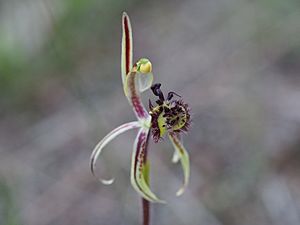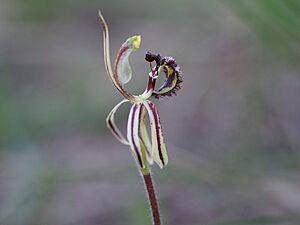Common dragon orchid facts for kids
Quick facts for kids Common dragon orchid |
|
|---|---|
 |
|
| Caladenia barbarossa growing near Williams | |
| Scientific classification | |
| Genus: |
Caladenia
|
| Species: |
barbarossa
|
| Synonyms | |
|
Drakonorchis barbarossa (Rchb.f.) D.L.Jones & M.A.Clem. |
|
The Common Dragon Orchid (scientific name: Caladenia barbarossa) is a special type of orchid. It grows only in the south-west part of Western Australia. This orchid is famous for its unique labellum, which is a special part of the flower. It looks so much like a female wasp that it attracts male thynnid wasps!
Contents
What Does the Dragon Orchid Look Like?
The Common Dragon Orchid is a plant that grows from an underground tuber (like a small potato). It has one hairy leaf, which is usually about 40 to 60 mm (1.6 to 2.4 inches) long and 5 to 10 mm (0.2 to 0.4 inches) wide. This plant is a perennial, meaning it lives for more than two years. It is also deciduous, so its leaf might fall off during certain seasons.
In spring, this orchid grows one, or sometimes two, flowers on a stalk. This stalk can be 100 to 300 mm (4 to 12 inches) tall. Each flower is about 25 to 40 mm (1 to 1.6 inches) long and 20 to 30 mm (0.8 to 1.2 inches) wide. The flowers are usually cream-colored or greenish-yellow, with cool red markings.
Flower Parts
The flower has different parts that look like petals.
- The dorsal sepal is the top part, standing straight up. It's about 18 to 25 mm (0.7 to 1 inch) long.
- The lateral sepals spread out below the flower. They are also 18 to 25 mm (0.7 to 1 inch) long.
- The petals spread out wide too, but they are a bit shorter and narrower than the sepals. Their tips curl inwards.
The Amazing Labellum
The most interesting part is the labellum. This part looks just like the body of a female thynnid wasp that doesn't have wings! It's attached to the flower by a stiff hinge. The labellum has a fake "insect abdomen" that is 8 to 10 mm (0.3 to 0.4 inches) long and 6 to 8 mm (0.2 to 0.3 inches) wide. This part is curved and covered with many maroon-colored hairs. It also has special bumps called calli. The fake "head" of the wasp is blackish and about 3 mm (0.1 inches) wide. It has two large, thick calli on each side, about 2 mm (0.08 inches) long.
How it Got its Name
The Common Dragon Orchid was first described by a scientist named Reichenbach in 1871. He saw a sample collected by James Drummond near the Swan River in 1843.
The name barbarossa comes from the famous historical figure Barbarossa. He was known for his red beard, and the orchid's red markings might have reminded someone of that! Some scientists later suggested changing the orchid's name to Drakonorchis barbarossa, but most people still use the original name.
Where Does it Live?
The Common Dragon Orchid is found in many places across Western Australia. You can see it between Bindoon, Ravensthorpe, and Esperance. It grows in sandy or clay soils, especially in wet areas. You can often find it in places with Casuarina trees.
How Does it Get Pollinated?
This orchid has a clever way to get pollinated! Male thynnid wasps are tricked by the labellum, which looks like a female wasp. The male wasps try to mate with the flower. When they do, they accidentally pick up or drop off pollen, helping the orchid reproduce. A male Thynnoides bidens wasp has even been seen on the labellum of this orchid!
Is it in Danger?
Good news! The Western Australian Government's Department of Parks and Wildlife says that Caladenia barbarossa is "Not Threatened." This means it's not currently in danger of disappearing.


